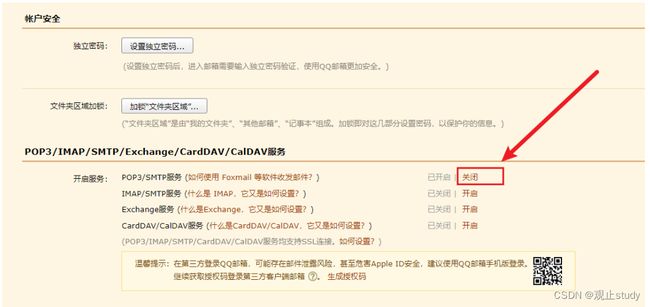引入QQ邮箱发送验证码进行安全校验
其他方案=>引入短信服务发送手机验证码进行安全校验
操作相对复杂且收费,详细教程可供参考选择
最近想给自己的项目在注册时加点安全校验,本想着使用短信验证码,奈何囊中羞涩只能退而求次改用QQ邮箱验证注册~
一.需求分析
-
场景:用户输入自己的邮箱,点击获取验证码,后台会发送一封邮件到对应邮箱中。
-
分析:防止刷爆邮箱,可以限制一分钟内只能获取一次。
- 前端:期限内禁用button按钮。
- 后端:存入redis设置过期时间,请求先判断redis中是否有数据。
二.环境准备
(1) 邮箱环境
在QQ邮箱中开启SMTP服务,获取授权码
点击开启后会得到一串授权码,后端程序中需要用到。
(2) 后端环境
大概率是在web项目中使用到,因此我们创建一个SpringBoot工程
- 创建好项目后在pom文件中导入操作邮箱所需jar包
<dependency>
<groupId>javax.activationgroupId>
<artifactId>activationartifactId>
<version>1.1.1version>
dependency>
<dependency>
<groupId>javax.mailgroupId>
<artifactId>mailartifactId>
<version>1.4.7version>
dependency>
<dependency>
<groupId>org.apache.commonsgroupId>
<artifactId>commons-emailartifactId>
<version>1.4version>
dependency>
- 由于我们需要在spring项目使用redis缓存验证码因此还要导入redis的jar包
<dependency>
<groupId>org.springframework.bootgroupId>
<artifactId>spring-boot-starter-data-redisartifactId>
dependency>
- 在yml文件中配置redis,设置了redis密码记得加上密码配置
spring:
redis:
# redis数据库索引(默认为0),我们使用索引为3的数据库,避免和其他数据库冲突
database: 3
# redis服务器地址(默认为localhost)
host: localhost
# redis端口(默认为6379)
port: 6379
三.后端程序
(1) 效果实现
- 发送邮箱应该算个工具,因此我们可以在工具类中写入如下代码
package com.example.utils;
import org.apache.commons.mail.EmailException;
import org.apache.commons.mail.SimpleEmail;
public class SendMailUtil {
/**
* 发送邮件代码
*
* @param targetEmail 目标用户邮箱
* @param authCode 发送的验证码
*/
public static void sendEmailCode(String targetEmail, String authCode) {
try {
// 创建邮箱对象
SimpleEmail mail = new SimpleEmail();
// 设置发送邮件的服务器
mail.setHostName("smtp.qq.com");
// "你的邮箱号"+ "上文开启SMTP获得的授权码"
mail.setAuthentication("[email protected]", "fbsxxxxxsijdj");
// 发送邮件 "你的邮箱号"+"发送时用的昵称"
mail.setFrom("[email protected]", "观止");
// 使用安全链接
mail.setSSLOnConnect(true);
// 接收用户的邮箱
mail.addTo(targetEmail);
// 邮件的主题(标题)
mail.setSubject("注册验证码");
// 邮件的内容
mail.setMsg("您的验证码为:" + authCode+"(一分钟内有效)");
// 发送
mail.send();
} catch (EmailException e) {
e.printStackTrace();
}
}
}
- 编写如下接口
@RestController
public class SendMail {
@PostMapping("/getCode")
@ResponseBody
public String mail(@RequestParam("targetEmail") String targetEmail) {
// 随机生成六位数验证码
String authCode = String.valueOf(new Random().nextInt(899999) + 100000);
SendMailUtil.sendEmailCode(targetEmail,authCode);
return "ok";
}
}
- 让我们测试一下接口
GET http://localhost:8080/[email protected]
如此我们初步效果就已经实现啦~
(3) 缓存改进
上述程序我们疯狂发送请求可以一直发送邮箱,这显然不是我们所期待的,接下来我们加入redis来改进一下。
@RestController
public class SendMail {
@Resource
private RedisTemplate<String, String> redisTemplate = new RedisTemplate<>();
/**
* @param targetEmail 用户邮箱
* @return
*/
@GetMapping("/getCode")
@ResponseBody
public String mail(@RequestParam("targetEmail") String targetEmail) {
// 发送前先看下我们是否已经缓存了验证码
String yzm = redisTemplate.opsForValue().get("yzm");
// 判断是否存在
if (yzm == null){
// 生成六位数验证码
int authNum = new Random().nextInt(899999) + 100000;
String authCode = String.valueOf(authNum);
// 不存在,我们发送邮箱给用户
SendMailUtil.sendEmailCode(targetEmail, "你的验证码为:" + authCode + "(五分钟内有效)");
// 存入redis中,设置有效期为1分钟
redisTemplate.opsForValue().set("yzm", authCode, 1, TimeUnit.MINUTES);
return "发送成功";
}
// 存在,直接返回,不再发送邮箱~
return "请勿重复发送验证码";
}
}
如此再次测试,可以发现疯狂点击不再产生效果,成功被拦截,如此安全了许多

至此我们开始想要的效果便已经在小demo中实现了,接下来可以引入正式自己项目啦
四.线上部署问题
按上述代码本地运行正常,但部署到线上环境如果产生如下错误:
1.Sending the email to the following server failed : smtp.163.com:465
2.Could not connect to SMTP host: smtp.163.com, port: 465
3.No appropriate protocol (protocol is disabled or cipher suites are inappropriate)
原因:阿里云等服务器厂商禁用了默认的25端口,我们需要使用例如465等可用端口发送邮件并开启ssl连接,并进行如下相关配置即可,最后在服务器防火墙开放对应窗口即可。
/**
* 验证获取操作安全证书
*/
public class CheckCodeUtils {
/**
* 发送邮件代码
*
* @param targetEmail 目标用户邮箱
* @param authCode 发送的验证码
*/
public static String GetEmailCode(String targetEmail, String authCode) {
try {
// 创建邮箱对象
SimpleEmail mail = new SimpleEmail();
// 设置发送邮件的服务器
mail.setHostName("smtp.qq.com");
// "你的邮箱号"+ "上文开启SMTP获得的授权码"
mail.setAuthentication("[email protected]", "GHNUxxxxxVL");
// 发送邮件 "你的邮箱号"+"发送时用的昵称"
mail.setFrom("[email protected]", "伙伴匹配系统");
// 发送服务端口
mail.setSslSmtpPort(String.valueOf(465));
// 使用安全链接
mail.setSSLOnConnect(true);
System.setProperty("mail.smtp.ssl.enable", "true");
System.setProperty("mail.smtp.ssl.protocols", "TLSv1.2");
// 接收用户的邮箱
mail.addTo(targetEmail);
// 邮件的主题(标题)
mail.setSubject("注册验证码");
// 邮件的内容
mail.setMsg("【伙伴匹配系统】您的验证码为:" + authCode + "(5分钟内有效)");
// 发送
mail.send();
return "发送成功,请注意查收";
} catch (EmailException e) {
return e.getMessage();
}
}
}
五.前端(补充)
代码如下:
DOCTYPE html>
<html lang="en">
<head>
<meta charset="UTF-8">
<title>Titletitle>
head>
<body>
<div>
<input id="mail" type="text">
<button id="getCode">获取验证码button>
div>
<script>
/*按钮禁用60秒,并显示倒计时*/
function disabledButton() {
const getCode = document.querySelector("#getCode")
getCode.disabled = true
let second = 60;
const intervalObj = setInterval(function () {
getCode.innerText = "请" + second + "秒后再重试"
if (second === 0) {
getCode.innerText = "获取验证码"
getCode.disabled = false
clearInterval(intervalObj);
}
second--;
}, 1000);
}
document.querySelector("#getCode").addEventListener('click', function () {
const mail = document.querySelector("#mail")
let xhr = new XMLHttpRequest();
xhr.open("GET", "http://localhost:8080/getCode?targetEmail=" + mail.value, true);
xhr.send();
xhr.onreadystatechange = function () {
if (xhr.readyState === 4) {
alert(xhr.response);
disabledButton()
}
}
})
script>
body>
html>




